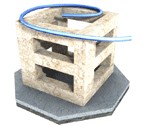Welcome to
HCEA 2019

Prof.Tao-Yun Han, President of Taiwan Society of Construction Engineering, Taiwan, China
Construction Automation
Architecture, Engineering and Construction (AEC) practice involve skills and technologies cross multiple areas. Starting from obtaining land, planning and design, sales, construction, all the way to delivering and managing the property, related operational SOP is quite complicate. Certain portion of the processes may be suitable to standardize, and therefore, can be automated. Applying the modern Information Technology (IT) to construction automation should be able to improve the quality and efficiency in construction engineering. Following the development of modern Information Technology, Internet, IoT and big data analytics have already been applied to certain manufacturing processes. Automated data collection during manufacturing processes, analyze the data, and adjust manufacturing parameters based on the analysis results has improved the manufacturing productivity and product quality. Similar concept and technology may be applied to constructing engineering in design, manufacturing, construction and management, and even extend to safety inspection and maintenance of the structure during its lifetime. However, the onsite construction environment is much more complicate than that in a manufacturing facility. There are many unexpected variables may happen and need be considered. Therefore, for safety purpose, in such application an automated process must have manual override mechanism. This article will discuss three possible automation areas as examples, and introduce some concept in applying Information Technology to certain construction processes and management. One is to pre-build certain structure components which can be standardized in a well-controlled production environment. Monitoring and collecting manufacturing data in the process, and modify manufacturing parameters based on the analysis result of the collected data. Consequently, improve product quality and reduce failure rate. Second one is using automatic equipment in assembling those standardized structure components onsite. Utilize measuring devices to monitor related data to identify improper assembling and make necessary correction. Another possible application is to setup monitoring devices in structure components, decoration elements, power equipment and life support system. During the life time of a building or structure object such devices will automatically submit necessary monitoring data, and use such information for safety inspection and maintenance. There are multiple areas in Construction Automation worth to consider and investigate. This article just give brief discussion in three examples as a starting point. Hopefully, this will trigger more advanced research and implementation, and finally, fully utilize Information Technology to achieve innovation in Construction Automation.

A. Prof. Fangfang Li, China Agricultural University, China
Identification of Flow Fluctuation for Fish Spawning and Multi-Objective Optimization of Reservoir Operation Considering Ecohydrological Need Downstream
The construction and operation of water conservancy projects changes the original runoff pattern of rivers and destroyed the suitable habitat conditions of aquatic organisms. The impact of the natural flow changes on the aquatic organisms is mainly instantiated by the fish. Studies have demonstrated that the increasing process of the water flow is the main factor that stimulates fish to lay eggs. Based on the discrimination of the rising and falling flow edge, an automatic identification algorithm of natural flood process is established, and an index system of ecological characteristics of natural flow is proposed to quantitatively describe the rising and falling process. The multi-objective optimization model of reservoir operation considering both the ecohydrological need downstream and the power generation benefits is proposed, which is applied on the Yangqu Hydropower Station on the upper reaches of the Yellow River. The results indicate that the proposed algorithm can effectively extract the characteristic parameters of natural flood process, and through the optimization, the power generation benefit is considerable under the premise of little disturbance to the fish spawning grounds in the lower reaches.

Prof. Genquan Qin, Jiangxi Provincial Water Conservancy Planning and Designing Institute, China
Key Technical Problems of Design and Construction of Jingdezhen Wuxikou hydro-junction project in Jiangxi Province
Jingdezhen Wuxikou hydro-junction project is one of 172 important water-saving projects in China, and it is also a World Bank loan project. The Project is an important part of the flood control system of the historic city - Jingdezhen, known as the capital of porcelain. Recently completed, It is a large-scale reservoir( Category 2), a Grade-II project, with normal water level of 56 m, dead water level 45 m, flood-control water level limit 50 m, design flood level 62.30 m, check flood level 64.30 m, total reservoir storage capacity 474.7 million m3 , regulating storage capacity 133 million m3, power plant installed capacity 32 MW. In the layout of the project, along the axis from left to right, the dam is arranged as follows: left-bank non-overflow RCC dam section (163.72 m in length), surface-overflowing spillway (5 holes, 78.00 m), low-hole spillway (6 holes, 108.00 m), power plant section (2 big generator units, 1 small generator unit, 43.10 m in length), right-bank non-overflow RCC dam section (installation workshop section included, 105.80 m in length). The total length of the dam is 498.62 m. The non-overflow dam sections of the Wuxikou project are the roller compacted concrete gravity dams, with crest elevation of 65.5 m, maximum height of 46.80 m, crest width of 8.0m.
Taking the construction process as the main line, this report systematically introduces the key technical problems of the project, such as the planning, design, construction and scheduling operation. It is rich in content and can help to understand the technical development of large-scale water resources development and construction projects in China.
To be added more...






